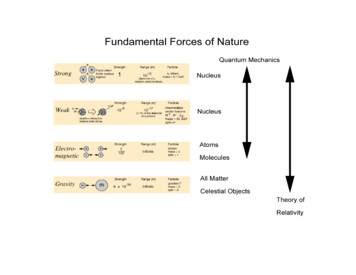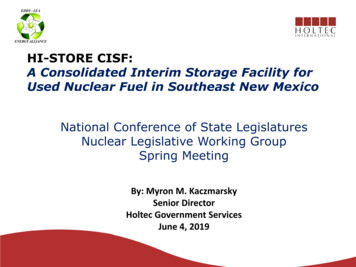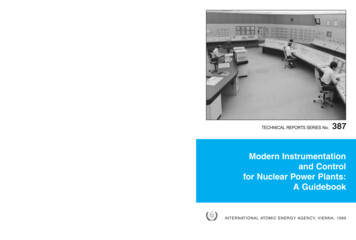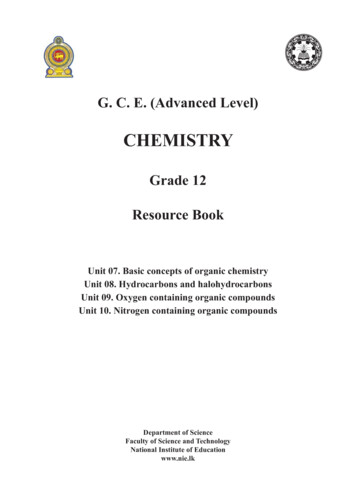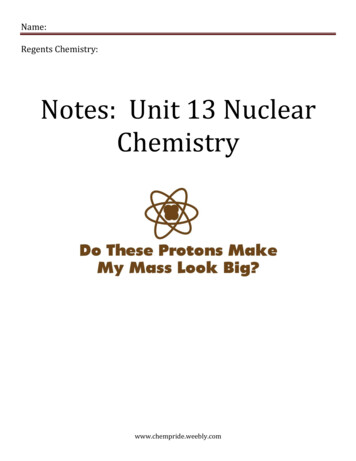
Transcription
Name:Regents Chemistry:Notes: Unit 13 NuclearChemistrywww.chempride.weebly.com
Name:KEY IDEAS: Stability of isotopes is based in the ratio of neutrons and protons in its nucleus. Although most nuclei arestable, some are unstable and spontaneously decay, emitting radiation. (3.1o)Each radioactive isotope has a specific mode and rate of decay (half-life). (4.4a)A change in the nucleus of an atom that converts it from one element to another is called transmutation.This can occur naturally or can be induced by the bombardment of the nucleus by high-energy particles.(5.3a)Spontaneous decay can involve the release of alpha particles, beta particles, positrons, and/or gammaradiation from the nucleus of an unstable isotope. These emissions differ in mass, charge, ionizing power,and penetrating power. (3.1p)Nuclear reactions include natural and artificial transmutation, fission, and fusion. (4.4b)There are benefits and risks associated with fission and fusion reactions. (4.4f)Nuclear reactions can be represented by equations that include symbols which represent atomic nuclei(with the mass number and atomic number), subatomic particles (with mass number and charge), and/oremissions such as gamma radiation. (4.4c).Energy released in a nuclear reaction (fission or fusion) comes from the fractional amount of massconverted into energy. Nuclear changes convert matter into energy. (5.3b)Energy released during nuclear reactions is much greater than the energy released during chemicalreactions. (5.3c)There are inherent risks associated with radioactivity and the use of radioactive isotopes. Risks can includebiological exposure, long-term storage and disposal, and nuclear accidents. (4.4e)Radioactive isotopes have many beneficial uses. Radioactive isotopes are used in medicine and industrialchemistry, e.g., radioactive dating, tracing chemical and biological processes, industrial measurement,nuclear power, and detection and treatment of disease. (4.4d)www.chempride.weebly.com
Vocabulary:WordAlpha ParticleArtificial transmutationAtomic MassAtomic Mass Unit (amu)Atomic numberBeta ParticleDeflectEmitGamma RadiationHalf-lifeIsotopeMass defectMass numberNatural radioactivity(Radioactive Decay)NeutronNuclear chargeNuclear fissionNuclear fusionNucleonNucleusParticle onA form of radioactive decay equivalent to a Helium-4 nucleus.Changing one element into another by bombarding it with particle bullets in aparticle accelerator.The weighted average of all naturally occurring isotopes of an element.1/12 the mass of a C-12 atom, the approximate mass of protons and neutrons.The number that identifies an element, equal to an atom’s number of protons.A form of radioactive decay equivalent to an electron.Change in direction due to an outside force.To give off something.A high energy form of radioactive decay with no mass or charge.The time it takes for half the mass of a sample of radioactive isotope toundergo decay. The period of time in which any given nucleus has a 50%chance of undergoing radioactive decay.Atoms of the same element that contain different numbers of neutrons andtherefore differ in atomic mass as well.The mass that was lost during a nuclear change that was converted intoenergy via E mc2.The sum total of the protons and neutrons in an atom.The spontaneous breakdown of an unstable nucleus into a more stable nucleusand a decay particle (alpha, beta-negative, beta-positive or gamma).The particle that has no charge and has a mass of 1 a.m.u.The net positive charge of the nucleus, equal to the number of protons in thenucleus.The process whereby a large nucleus is split by artificial transmutation intosmaller nuclei with the release of a large amount of energy derived from theconversion of a tiny bit of mass into energy.The process whereby two small nuclei are combined to form one largernucleus with release of a huge amount of energy derived from the conversionof a tiny bit of mass into energy.A particle that exists in the nucleus (protons and neutrons.)The central core of the atom, consists of protons and neutrons and has a netpositive charge.A device that uses electromagnetic fields to accelerate charged particles.A particle that represents a unit charge of 1 and a mass of 1 a.m.u.An isotope of an element which is radioactive (undergoes spontaneous decay).A change to the nucleus of an element which produces a new element.www.chempride.weebly.com
Lesson 1: Radioactive DecayObjective: Construct nuclear equations for the spontaneous decay of radioactiveReview:nuclides.ISOTOPES are atoms of the same element that have the same # of PROTONS but different #of NEUTRONS or mass.Atomic Notation:Subtract atomic number from mass number to find the NEUTRONSRADIOACTIVE DECAY: The process by which nuclei emit particles and change into new elements (calledTransmutation). Only deals with PROTONS and NEUTRONS (these are in the nucleus).o Identity of an element changes due to change in number of protonsNATURAL RADIOACTIVITY (Transmutation): Occurs when UNSTABLE atoms (radioactive) decay into new atoms. ALWAYS TURNS INTO A MORE STABLE ELEMENTRADIOACTIVITY: Is due to the proton-neutron ratio. The band of stability refers to atomsthat are stable due to stable proton-neutron ratios.www.chempride.weebly.com4
Lesson 1: Radioactive DecayTo determine the product of radioactive decay of an unstable nucleus, use Tables Nand O TABLE N: DECAY MODES -- look up nuclide to get type of decayTABLE 0: TYPES OF DECAY – use to get mass and charge of decayed particlewww.chempride.weebly.com5
Lesson 1: Radioactive DecayRadioactivity: BETA DECAY Atoms above the stability belt have too many neutrons and beta decay due to this. The beta particle is an electron created when a neutron decays.Example: Beta decay: 234Th undergoes beta decay The total mass on the left must equal the total mass on the right (234 0 234)The total charge on the left must equal the total charge on the right (90 -1 91)Find the new symbol using the charge (number of protons) for the atomic numberExample:14Cundergoes Beta decay:Radioactivity: POSITRON EMISSION Atoms below this belt have too many protons and positron decay. The positron is the opposite of a beta particle.Example: Positron emission: 37K undergoes positron decay The total of the mass numbers on the left must equal the total on the right (37 0 37)The total charge on the left must equal the total charge on the right (19 1 18)Example:37Cawww.chempride.weebly.com6
Lesson 1: Radioactive DecayRadioactivity: ALPHA DECAY Atoms with 82 or more protons alpha decay (too many protons and neutrons) Alpha particles are weak due to their mass. Alpha particles are the helium nuclei.Example: Alpha decay: 238U undergoes alpha decay The total mass on the left must equal the total mass on the right (238 4 234)The total charge on the left must equal the total charge on the right (92 2 90)Example: Francium-220Radioactivity: GAMMA DECAY Strongest particle. Accompanies most decay. Usually not written due to the fact that it cannot change the mass or charge of any of thespecies.www.chempride.weebly.com7
Lesson 1: Radioactive DecayPenetrating Power of RadiationAlpha is least penetrating then beta. Gamma is most penetrating.Radiation is charged: can be separated by a magnetic fieldwww.chempride.weebly.com8
Lesson 2: Half LivesObjective: Calculate the half-lives of selected nuclidesHALF LIVES: The time it takes for half the atoms in a given sample of an element to decay. Radioactive substances decay at a rate that is NOT dependent on temperature, pressure,or concentrationCalculating Half Lives: After one half life 50% or ½ the radioactive element is still present. After two half lives 25% or ¼ the radioactive element is still present. After three half lives 12.5% or 1/8 the radioactive element is still present. This continues forever, the number will never be zero. The half lives are listed on Table N. The SHORTER THE HALF LIFE of an isotope the LESS STABLE it is.The LONGER THE HALF LIFE of an isotope the MORE STABLE it is.CALCULATING HALF LIFE PROBLEMSExample: Amount RemainingIf a sample of I-131 has an original mass of 52.0g what mass will remain after 40 days?1. Look up half life of I-131 and determine how many half lives havepassed by dividing the time passed by the half life.40/8.021 5 half life periods2. Cut the original mass in half by the # of half life periods#Half Lives012345Mass52.0gFraction1After 40 days 1.63 grams of I-131 is leftExample: Fraction RemainingIf a sample of I-131 has an original mass of 52.0g what fraction will remain after 40 days?Same set up as above, but now start with the whole (1) and cut that in half each half life.After 40 days 1/32 of I-131 is leftwww.chempride.weebly.com9
Lesson 2: Half LivesExample: Number of Half LivesHow many half-life periods will it take for 50 grams of Tc-99 to decay to 6.25g?1. Find the number of half lives by halving the original mass until you get to the finalmass50/2 25/2 12.5/2 6.25 3 Half LivesCan also do in table form:#Half e: Half LifeWhat is the half-life of a 500 gram sample of a radioactive element if 125 grams remains after20 hours?1. Find the number of half lives by halving the original mass until you get to the finalmass500/2 250/2 125 2 HL2. Divide the time elapsed by the number of half lives you calculated.20 hours/2 10 Hour half life.Example: Original MassThe half like of Tc-99 (used in brain tumors) is 6 hours. If 10 micrograms are left after 24 hrs,how much was administered to the patient originally?1. Divide the times to obtain your amount of half lives24/6 4 half lives2. Start with the ending mass and instead of halving, you double your amount thenumber of half lives you calculated, since we are going backwards!10*2*2*2*2 160 microgramsExample: Time ElapsedHow long will it take for a 400 grams sample of P-32 to decay to 50 grams?1. Find the half lives by dividing the original mass in half until it hits your final mass.400/2 200/2 100/2 503 half lives2. Look up the half live on table N and multiple that time by the number of half livesyou calculated.14.3 days * 3 42.9 dayswww.chempride.weebly.com10
Lesson 3: Nuclear Fusion and FissionObjective: Determine the type of nuclear reactionDetermine benefits and risks associated with fission and fusion reactionsARTIFICAL TRANSMUTATION:Involves a high speed particle bombarding the nucleus. This occurs in particle accelerators. Artificial TransmutationAlways 2 reactants Natural TransmutationAlways 1 reactantFISSION REACTIONS:A NEUTRON is shot at a radioactive source which splits producing ENERGY. If the number OF NEUTRONS released is not controlled a CHAIN REACTION will occur.This is the type of reaction used in nuclear bombs.FISSION REACTORS:The reaction’s energy is converted to steam which turns and turbine system, creatingelectrical energy from nuclear energy. Fuel rods contain the fissionableradioactive source.CONTROL RODS can regulate theneutrons absorbed.Cooling Fluid acts as a moderator,slowing neutrons down.www.chempride.weebly.com11
Lesson 3: Nuclear Fusion and FissionNUCLEAR POWER: In America, about 20% electricity generated by nuclear fission Imagine:o Nuclear-powered caro Fuel pencil-sized U-cylindero Energy 1000 20-gallon tanks of gasolineo Refuel every 1000 weeks (about 20 years)FUSION REACTIONS: Involves THE COMBINING OF NUCLEI to produce HEAVIER ONES.4He 1n Ex. 2H 3H Fusion Reactions:Advantages DisadvantagesProduces more energyMaterials more readily availableLess wasteLess danger (no chain reaction) Too ExpensiveEXAMPLE: Which represents artificial Transmutation?1. 92U2382He4 90Th2342. 13Al27 2He415P30 0n13. 6C147N14 e04. 88Ra2262He4 86Ra222www.chempride.weebly.com12
Lesson 4: Benefits and Risks of Nuclear ReactionsObjective: Determine benefits and risks associated with fission and fusion reactionsBENEFITS OF RADIOACTIVE ISOTOPESDATING MATERIALS: CARBON-14 used to date organic remains URANIUM used to date rocksMEDICAL APPLICATIONS: Must have A SHORT HALF LIFE and quickly eliminated from bodyIODINE-131 (treat hyperthyroidism)COBALT-60 used to treat cancerTC-99 used to detect tumorsDANGERS/RISKS OF RADIOACTIVE ISOTOPES Damage to TISSUEGene MUTATIONSACCIDENTS due to radioactive wastesRADIATION from nuclear reactorswww.chempride.weebly.com13
1. Divide the times to obtain your amount of half lives 24/6 4 half lives 2. Start with the ending mass and instead of halving, you double your amount the number of half lives you calculated, since we are going backwards! 10*2*2*2*2 160 micrograms Example: Time Elapsed How long will



